ISSN ONLINE(2319-8753)PRINT(2347-6710)
ISSN ONLINE(2319-8753)PRINT(2347-6710)
| R. K. Aruna , B. Janarthanan Department of Physics, Karpagam University, Coimbatore – 641021, Tamilnadu, India |
| Related article at Pubmed, Scholar Google |
Visit for more related articles at International Journal of Innovative Research in Science, Engineering and Technology
An attempt has been made to simulate the floating cum tilted-wick type solar still in the climatic conditions of Chennai and Visakapatnam. The still has been designed, fabricated and experimentally analyzed in the Department of Physics, Karpagam University, Coimbatore, India. The parametric influence on the performance of the proposed system has been found and presented. The results have shown that the performance of the system is mainly influenced by the water mass flow rate of salt water in the tilted-wick portion, absorptivity of the wick surface and the intensity of solar radiation. It is also found that the performance of the proposed floating cum tilted-wick type solar still is better in both Chennai and Visakapatnam and the design is suitable for large scale installations to produce distilled water with less maintenance.
Keywords |
| Wick-type solar still, Distillate yield, Efficiency, Absorptivity, Mass flow rate |
INTRODUCTION |
| Water is essential for life to fulfill the basic requirements for domestic, industrial and agricultural activities. Nowadays pure water scarcities intensify the researchers all over the world to find a desperate solution. In such scenario, solar desalination seems to be a simple technology, eco-friendly, lower maintenance and no energy costs due to which it can be used anywhere with lesser number of problems. |
RELATED WORK |
| Many researchers have made sincere efforts to study the performance of different designs of solar still and succeeded. Boukar and Harmin (2001) have studied the effect of desert climatic conditions on the performance of a simple basin solar still and still coupled to a flat plate solar collector. It has been inferred that the productivity of the proposed system strongly depends on solar radiation and ambient temperature. |
| A mathematical model has been developed for the productivity of a simple solar still for different climatic, design and operational parameters by Al-Hinai et al. (2002). It has been found that 230 cover tilt angle, 0.01m insulation thickness and asphalt coating of the still is found to be optimum design parameter for maximum production of distilled water. Further Al-Hinai et al. (2002) have proposed two mathematical models for single effect and double effect solar stills to compare the productivity with optimum 230 cover tilt angle, 0.01m insulation thickness and asphalt coating. It has been concluded that the unit cost for distilled water using a double-effect solar still lead to the saving percentage of 15.7. |
| Rubio et al. (2004) have proposed a new lumped parameters mathematical model to predict the thermal asymmetries in temperature and distillate yield in double slope solar stills by considering the condenser as a two-element system. It has been found that the theoretical results are in good agreement with the experimental observations. |
| Analytical expressions for water and glass temperatures, hourly yield and instantaneous efficiency for double slope solar still have been developed by Shukla and Rai (2008) using energy balance equations. The results have shown a significant effect of operating temperature range on the internal heat transfer coefficients and also reasonable agreement between the experimental and theoretical results when the inner glass cover temperature is used. A single basin double slope solar still has been designed and fabricated by Kalidasa Murugavel et al. (2008) and tested under laboratory conditions by using light cotton cloth, light jute cloth, sponge sheet of 2mm thickness and porous materials like washed natural rock and quartzite rock as spread materials in the basin to maintain thin layer of water. Solar radiation condition has been simulated by 2 kW electrical resistance heater placed below the inner basin. It has been inferred that black light cotton cloth as spread material has produced higher distillate yield than other spread materials. Further Kalidasa Murugavel et al. (2010) have fabricated single basin double slope solar still and used different sensible heat storage materials like quartzite rock, red brick pieces, cement concrete pieces, washed stones and iron scraps in the basin. It has been found that ¾ inch sized quartzite rock is the effective basin material for higher production rate. |
| Rahul Dev et al. (2010) have proposed a characteristic equation of a double slope passive solar still by using experimental observations for climatic condition of New Delhi, India and found that the non-linear characteristic curves are more accurate to analyze the performance and normal testing of the proposed still. Light cotton cloth, sponge sheet, coir mate and waste cotton pieces has been used in the basin of double slope solar still and tested by Kalidasa Murugavel and Srithar (2011). It has been revealed that light black cotton cloth is the effective wick material to enhance the production of the still. Madholpa and Johnstone (2011) have proposed a model to evaluate the distribution of solar radiation inside a basin-type solar still with plane reflector. It has been found that the computed solar load on the surface of the saline water in the evaporation basin is lower than that of the load observed on a horizontal plane outside the energy system. Kabeel et al. (2012) have investigated the performance of stepped solar still theoretically and experimentally. It has been revealed that the theoretical results are in good agreement with the experimental observations and also stepped still with tray depth 5mm and tray width 120mm provided higher productivity of 57.3% than the conventional solar still. |
| In the present work, simulation modeling of floating cum tilted-wick type solar still has been undergone to find the influence of effective parameter on the performance of the still. Also the optimum mass flow rate of water in wick portions has been found for better performance of the still with enhanced distillate yield. The simulation has also been done to find the performance of the still in Chennai and Visakapatnam. |
DESIGN OF THE PROPOSED SYSTEM |
| Fig. 1 shows the photograph of a floating cum tilted wick type solar still of area 1m2. The bottom surface of the still was painted black for greater absorptivity. The glass cover of 4mm thickness covers the still. The inner dimension of the still is 1m*1m*0.38m and the outer dimension is being 1.17m*1.17m*0.53m. The gap between the inner and outer dimensions is filled with thermal insulator to minimize the heat loss. A jute wick material painted black is spread over the 13° tilted portion and the remaining part of the wick has been prepared in corrugated shape and made to float over the water reservoir of the still with a thermocole of 2cm thick. The water level in the reservoir was maintained so as not to overflow in the tilted portion and always to be 0.25 cm below the tilted portion through an inlet controlled by a valve. The corrugated floating wick always coincides with the upper level of the water in the reservoir which makes tilted wick always wet due to capillary action. This arrangement causes evaporation from the tilted wick and floating wick surfaces. |
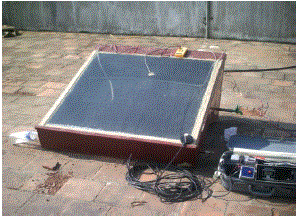 |
| Glass and wick temperatures were recorded with the help of calibrated copper constantan thermocouples and the distillate yield were observed for every 30 minutes. Solar radiation monitor and digital thermometer have been used to measure the solar radiation intensity and ambient temperature. |
| The hourly variation of solar intensity and solar fraction intercepted on the wick surfaces have been incorporated to write the energy balance equations for the temperature elements of the still. A computer program has been written for the analytical solutions of the energy balance equations to evaluate the thermal performance of the still in local climatic conditions in Coimbatore, Tamilnadu, India. |
| Energy balance equations have been written for the temperature elements of the proposed still with the following assumptions. |
| (i) The system is made vapor tight and well insulated with thermal insulator so that convection and conduction losses through the sides and bottom is minimized. |
| (ii) There is no temperature gradient on the condensing surface. |
| (iii) The transparent glass cover and wick surfaces are parallel due to the small inclination of the glass cover |
| (iv) The capillary action of the jute-wick material is good enough in evaporating brackish water and in yielding maximum amount of distillate output in less interval of time |
| (v) There is no vapor leakage in the still, thus a maximum amount of water vapor is condensed in to water. |
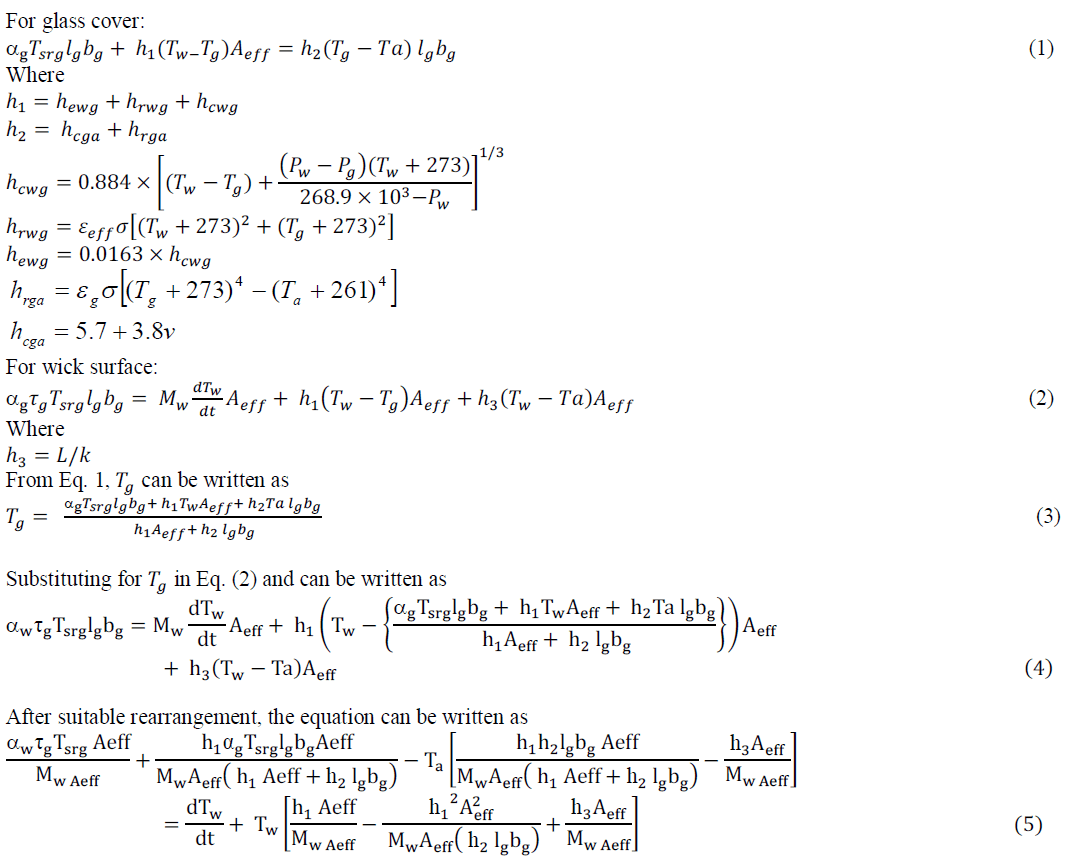 |
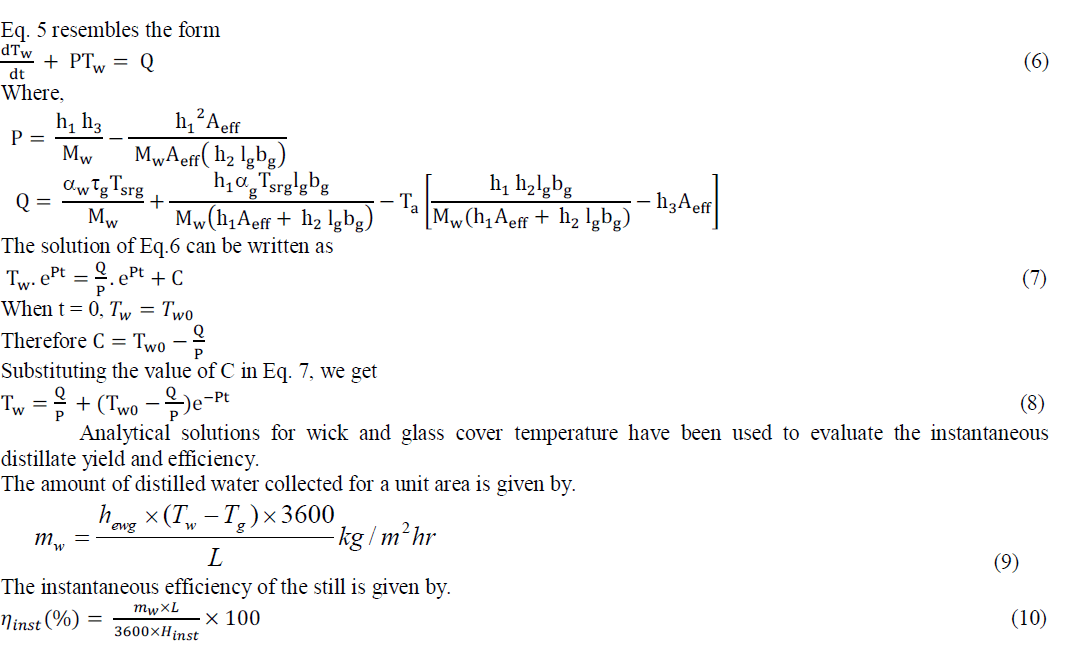 |
RESULTS AND DISCUSSION |
| Experiments have been conducted with the proposed design parameters and climatic parameters of the respective location and the relevant design parameters of the still used for the calculation are αw=0.88; L= 0.0040 m; Aw=1m2; ε=0.88; σ=5.66*10-8 W/m2K-4; S=13°; W= 1m : Lb= 1m. |
| The solar radiation and ambient temperature have been measured throughout the working days of the proposed system and observations for one of the typical days in the month of May has been used for the validation of the proposed thermal model in local climatic conditions in Coimbatore. Computer program has been written for the analytical solutions for the glass, wick temperatures, mass of the distillate yield and efficiency and evaluated for the working hours of the respective day. Fig. 2 shows the variation of solar radiation and ambient temperature for one of the typical days in the month of May in Coimbatore and it is observed that the intensity of solar radiation increased gradually during the morning hours and decreases gradually in the afternoon hours. The ambient temperature followed the same trend as that of the solar radiation throughout the working hours of the day. Fig. 3 shows the variation of glass cover and wick surface temperatures for the respective day and has been recorded by using calibrated thermocouples. Thermocouples have been fixed in three different positions on the glass cover and wick surfaces and the average has been taken for calculations. Graduated jars have been used to collect distillate yield and measured with an interval of 30 minutes. |
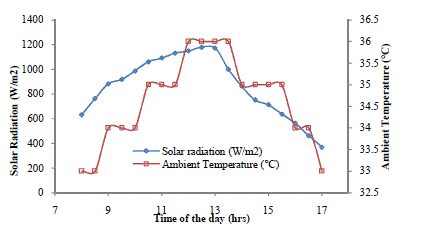 |
| The temperature of the wick surface reaches the maximum during 1 pm to 1.30 pm and gradually decreases. The maximum temperature of the wick obtained in the proposed model is found to be 79°C in the month of May at 1 pm. The maximum temperature of the wick surface provides a huge difference between the evaporating and condensing surface temperatures resulting in increased amount of rate of evaporation. Moreover the distillate yield is maximum when the solar radiation and ambient temperature are maximum during peak sunny hour. Hence the distillate yield is a function of solar radiation and ambient temperature. It has been found that the proposed still has the maximum daytime distillate yield in the month of May is 3.070 kg/m2 9 hrs. It may be concluded that the still’s performance is found to be good in the month of May due to good clearness index. In the month of May in one of the typical days the total distillate yield over 24 hrs cycle is found to be 4.570 kg/m2day, out of which 1.500 kg/m2 is night-time collection. The instantaneous efficiency depends on the distillate yield, solar radiation intensity and ambient temperature. When the solar radiation intensity, ambient temperature and distillate yield are high in particular interval of time, the efficiency at that instant seems to be high. The overall efficiency of the still is found to be 46% in the month of May by considering the effect of the shadows of side and back walls on the evaporating wick surface throughout the day. |
| To validate the proposed thermal model, computer program has been executed to find the glass cover temperature, wick temperature, instantaneous distillate yield and instantaneous efficiency and compared with the experimental observations. Experiments have been conducted throughout the year and observations of one of the typical days for all the months has been used to find the theoretical values for glass cover temperature, wick temperature, distillate yield and efficiency of the proposed still. |
| Relative standard deviation has been found between theoretical and experimental results for the glass cover and wick surface temperature, instantaneous distillate yield and efficiency for one of the typical days in all the months. Fig. 4 shows the relative standard deviation between glass cover and the wick surface temperatures for one of the typical days in each month. The relative standard deviation for the mass of the distillate yield and instantaneous efficiency of the proposed still has been found for the respective days of all the months and is depicted in Fig. 5. In addition to the accuracy of the thermal model, the proposed design is found to be continuously used for 15 days without the removal of salt in the tilted-wick portion. This is due to the fact that the salt content in the saline water settles down beneath the corrugated floating-wick i.e., thermocole. The salt diminished water flow towards the tilted-portion without spoiling much of the wicks absorptivity which provides an additional advantage of the proposed design. The numerical results obtained from the proposed thermal model is found to be in close agreement with the experimental observations in all the months with an error of less than 2%. |
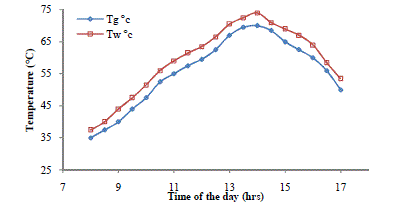 |
| From the above results obtained for the proposed thermal model, it is suggested that the model can be used for the simulation of floating cum tilted-wick type solar still in different locations. |
| In this study, daily average solar radiation of Chennai and Visakapatnam has been taken and the performance of the still has been found by simulating solar radiation of the respective locations in the proposed thermal model. Fig. 6 shows the variation of intensity of solar radiation and ambient temperature in Chennai for one of the typical days in the month of May. By using Eq. 3 and 8, the temperature of the glass cover and wick surface of the proposed still for climatic condition of Chennai has been evaluated and depicted in Fig. 7. It has been observed that the temperature of the wick and glass cover surfaces is higher than that in Coimbatore. This is due to the fact that the climate and weather of Chennai is consistent with less variation in seasonal temperature because of close proximity to the sea and the thermal equator. |
| Similarly the intensity of solar radiation and ambient temperature of Visakapatnam has been used to evaluate the temperature of the wick and glass cover surfaces. Fig. 8 shows the variation of solar radiation and ambient temperature for one of the typical days in the month of May and Fig. 9 shows the variation glass cover and wick surface temperatures of the proposed still for the climatic conditions of Visakapatnam. It is seen that the glass cover and wick surface temperatures are higher than that of Coimbatore because of very sultry climate with high humidity levels. |
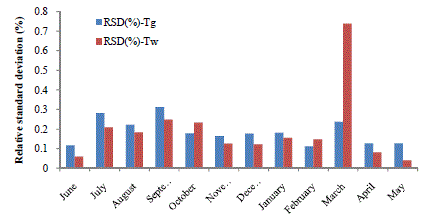 |
| The hourly variation of distillate output for one of the typical days in the month of May in Coimbatore, Chennai and Visakapatnam has been depicted in Fig. 10. It is seen that for all the locations, the hourly variation has same trend and the distillate output in Chennai and Visakapatnam is slightly higher than in Coimbatore. Though the climatic conditions of Chennai and Visakapatnam are hot and humid, the distillate output of the proposed still is not significantly higher than Coimbatore due to the fact that the difference between glass cover and wick surface temperatures did not increase. In Chennai and Visakapatnam, the intensity of solar radiation not only influencing the wick surface temperature but also the glass cover temperature. From this result, it has been observed that the proposed floating cum tilted-wick type solar still is suitable for Chennai and Visakapatnam. |
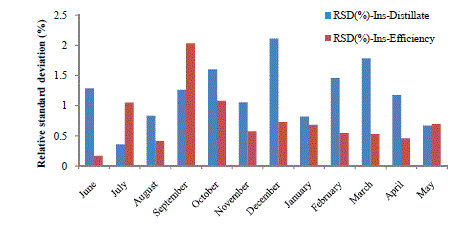 |
| Since the performance of the proposed still is slightly higher in Chennai and Visakapatnam than in Coimbatore, simulations have been proceeded to find the influence of absorptivity of wick surface on the performance of the proposed still in the local climatic conditions of Coimbatore, Tamilnadu, India. The hourly variations of the distillate output with respect to the variation of absorptivity of the wicks have been drawn in the Fig. 11. From the Fig. 11, it is observed that the hourly distillate output increases with the increase of absorptivity of the wicks. There exists enhancement of daily distillate output with increase of absorptivity of the wicks as mentioned by Yadav and Ashok Kumar (1991) and Yadav and Prasad (1991) for basin type solar still (increasing the absorptivity of the basin liner). |
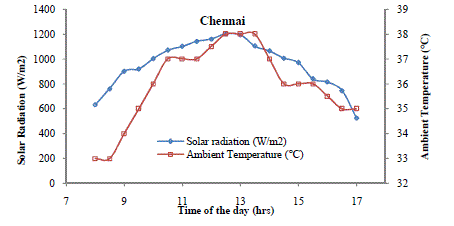 |
| The effect of mass flow rate of water in the tilted and floating-wick portion has been considered to predict the instantaneous efficiency of the proposed still. The analytical solution for the efficiency of the still has been used to evaluate the efficiency of the still. The mass flow rate of water has been varied as 2.5 x 10-3kg/s, 3.5 x 10-3kg/s and 4.5 x 10-3kg/s and the efficiency has been evaluated by using the computer program written for the solutions of the energy balance equations of the proposed still. Fig. 12 shows the variation of instantaneous efficiency of the still for varying mass flow rate of water in floating and tilted-wick portion. It has been observed that the efficiency gradually increases during morning hours and reaches the maximum at 1 pm for all the flow rate of water in the wick portion. It has been observed that the instantaneous efficiency of the still throughout the working hours of the day is higher for the flow rate of 2.5 x 10-3kg/s than the other flow rate. Hence it can be concluded that the decrease of flow rate increases the instantaneous efficiency of the still. |
| The maximum instantaneous efficiency of the still is found to be 57.31, 47.23 and 39.94% for 2.5 x 10-3kg/s, 3.5 x 10- 3kg/s and 4.5 x 10-3kg/s respectively. This led to the conclusion of optimum mass flow rate of water in tilted and floating wick portion as 2.5 x 10-3kg/s. |
CONCLUSION |
| The following conclusions have been drawn from the simulation modeling of floating cum tilted-wick type solar still |
| 1. The temperature of the wicks increases with the decrease of water flow rate. Moreover the optimum mass flow rate of water is found to be 2.5 x 10-3kg/s. |
| 2. The salt scale formation in the tilted-wick basin is less than the common tilted-wick type solar still and the problem of dryness of the tilted-wick in peak sunny hours have been overcome. |
| 3. The internal evaporative heat transfer coefficient is a very sensitive parameter of the wicks and glass temperatures. The internal convective and radiative heat transfer coefficients have not undergone any noticeable change though the mass flow rate varies. |
| 4. The absorptivity of the wicks is an important parameter of the hourly distillate output and the performance of the still. |
| 5. The proposed theory is used to optimize the still parameters and validates the empirical relations of internal heat transfer coefficients. |
| 6. The instantaneous efficiency of the still between 10 am to 2pm remains more or less the same. Theoretical results are in good agreement with the experimental results. |
| 7. Based on the simulation results for the performance of the still in Chennai and Visakapatnam, it has been inferred that the still is found to be suitable for the locations and can be utilized for large scale installations. |
| 8. The performance of the proposed still is found to be fascinating with less technical maintenance in comparison with the common tilted-wick type solar still. |
References |
|
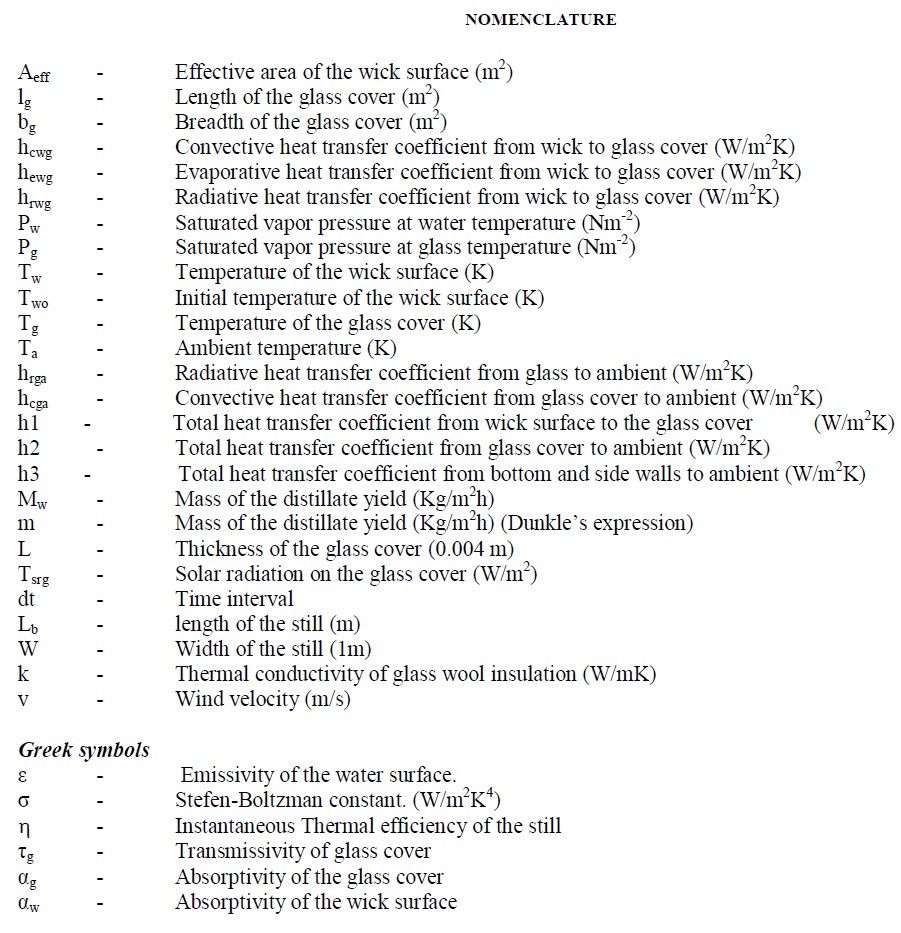 |